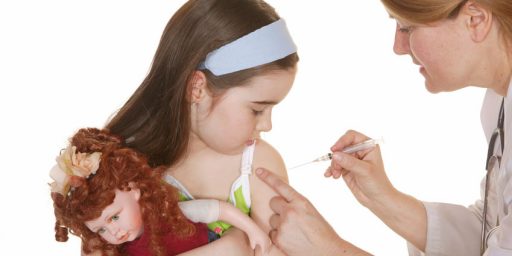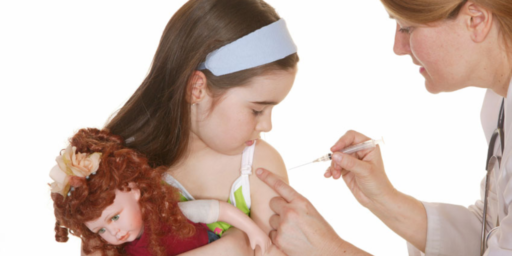So Much for the Autism Epidemic
Orac at Respectful of Insolence points to some new research that strongly suggests that the Autism “epidemic” either doesn’t exist or is much smaller than many have claimed.
The big problem is something called “diagnostic substitution.” In special education programs, “autism” was not a required category until created by the Americans with Disabilities Act of 1990. Suddenly, “autism” diagnoses for special education sky rocketed. At the same time things like “mental retardation” and other categories for mental disabilities declined. The researcher, Dr. Paul Shattuck, notes that this pattern has been observed in the past and that it was not the case that there was epidemic. In short, the problem is that there was a better diagnosis/classification scheme put into place and the primary data source that is often used to justify the “autism epidemic” claim is tainted and cannot be used to determine if there really is an epidemic.
Now, that last part does leave open the possibility that there was a surge in the rate of autism in the population precisely at the time that there were new diagnosis/classification categories. However, this research still implies that even if there is an increase that such an increase is not as was initially suspected. Here is what Dr. Shattuck has to say on this,
Steep growth in administrative prevalence after introducing a new category is a common pattern that was also seen in the other 2 reporting categories newly introduced in the 1990s (TBI and DD). As with autism, in the first few years these categories were used it was not uncommon for states to report very few children with a primary diagnosis of TBI or DD. The prevalence for these categories also had nowhere to go but up. Suggestions that special education trends substantiate the existence of an autism epidemic would logically also have to either claim an epidemic of brain injury and DD or explain why the same pattern of growth in these 2 categories does not represent an epidemic as it does for the autism category.–emphasis added
(Orac also provides the helpful hint that TBI= traumatic brain injury and DD=developmental delay.)
In short, if we are going to use the trends in a dataset to justify the existence of an epidemic for a given ailments, then logic requires that we do the same whenever we see other similar trends. Why would we expect an epidemic of TBI? Seems kind of weird to me, and given that in three cases where a new category is added we see similar trends in the data it seems that the most reasonable explanation for the observed trends was the introduction of the categories. The other option is to attribute epidemics to completely unknown causes.
This was one of the my first guesses as to the “rise in the number of cases with autism” back when I first heard about it. I was assured by people who were in favor of the epidemic hypothesis (e.g. Dwight Meredith) that this was not the case. However, autism was not even a required category in virtually all special education programs across the nation until after 1993.
Here is how Dr. Shattuck puts it with an example in an interview he gave,
For instance, consider data collected in Wisconsin: In 1992, 18 children were counted in special education programs as being autistic. By 2002, that number had jumped to 2,739.
“The conclusion is that the prevalence of autism has grown by 15,117 percent. This is ridiculous,” Shattuck said. “No credible clinician or scientist in the field would ever suggest there were actually only 18 children with autism in all of Wisconsin in 1992.”
The idea that rate of growth of autism is over 15,000 percent isn’t ridiculous, it is blindingly ludicrous.
A quick Google search turned up this kind of nonsense that careless research can lead too. Add in opportunistic politicians and you have a recipe for junk science. Lets look at the dates here. Hmmm…the article is published in 1999, so just in time for that new category to pop into the “developmental services system” under the new category. Now how many of those children were already in the system, but under a different category? Whoops, didn’t think to stop and ask that question.
The Department of Developmental Services report, “Changes in the Population of Persons with Autism and Pervasive Developmental Disorders in California’s Developmental Services System: 1987–1998” was released to the legislature this morning. While it confirms the increased incidence, the report does not examine factors leading to the increase. The report was required as a result of legislation developed after parents, human services professionals and educators expressed concern that they were seeing a dramatic increase in children with autism.
Gee, could it be because in 1993 there was no autism catagory for special education, and then in 1994 there was and all those kids who had autism were now migrating to the right catagory? Also, I strongly suspect that the report looks at the number of people entering the “system” and not things like, the number of people per 1,000 people in the state, or looking at population growth in California as well. That is, if the population of California grows by say 3% from 1987 to 1998 then there are 38% more people in California which, holding all other things constant there would be 38% more people with Autism entering the Department of Developmental Services simply due to population growth.
The bottom line is that large changes like a 273% increase could have very reasonable explanations and shouldn’t necessarily lead to hysteria. And as Orac has already discussed, it makes the chemical castration of children with autism even more dubious.
Update: I found the report (pdf), it is on the Department of Developmental Services website. Here is a nifty tidbit,
In this report the incidence of autism is not measured. The unit of measure reported here is the rate of occurrence of persons with autism or other PDDs in the regional center and developmental center system during a specified period of time.
In other words, the 273% number isn’t the same thing as there has been a 273% increase the incidence of autism–i.e. it isn’t necessarily becoming more frequent.
Also of interest is this picture from the report. Note that the population the picture refers to is the State population. If Autism were increasing in the population that time series for Autism would show an upwards trend. If there is one there it is very, very slight and possibly statistically meaningless.





I agree with you that putting the increase in the incidence of autism at 15,000% (or even 1,500%) is absurd. It’s even more absurd (as the autism lobby is peddling) to attribute the unproven increase to the use of thimerosal as a preservative in vaccines. As far as I’m concerned it’s just rent-seeking.
However, to claim no increase at all is counter-intuitive and, what’s more, doesn’t seem to be borne out by the data. As you note in your conclusion, there’s possibly a very, very small increase.
Complicating the analysis is that there is no single cause for autism�there are many causes from environmental to social to genetic. There may be even a few kids whose autism is due to mercury poisoning.
I’m willing to bet that as cancer was discovered for what it was, the number of diagnosis of cancers grew at a rate that didn’t make much sense, either.
I suspect much of the increase it due to better diagnosis. Although when it comes to school system data, a lot of kids with PDD’s are not classified with autism for special education purposes. Asperger’s Syndrome and PDD-NOS are often given the “other health impaired” or “developmental delay” and sometimes “speech and language impaired” catagories.
But I have a child with autism, and I am pretty convinced that probably a lot of kids on the spectrum probably were misdiagnosed with mental retardation, then you factor in that Asperger’s Syndrome, wasn’t an official diagnosis until the 1990’s, so many of those kids on the spectrum may not have been identified at all by the school systems (or they would have been miscatagorized into some other catagory).
I do agree with the poster above, that while I think a large portion of new diagnosis are really just better diagnosis, I think it may be a mistake to chalk all of the increase up to this theory.
I am not a huge fan of the vaccine theory causing autism-the MMR or thimerasol connection, but I do wonder if there isn’t some environmental factor that hasn’t quite been identified yet. My view is that it is mostly genetic, but there is also probably some degree of environmental factor involved-I think it is more likely something that is triggered during pregnancy than post pregnancy. My son has an autism spectrum disorder, and while I didn’t recognize symptoms in infancy at the time-looking back you can see a lot of the symptoms in his behaviors from the time he was a newborn.
I am a single mother of 2 autistic children, At first I did believe that the MMR shot with the thimerosal was to blame. At the time I found out my first child was autistic, I was 6 months pregnant with my second child. I took precautions and did NOT give my second child ANY immunizations. He is also autistic.
I do believe though that there is an increase of autistic cases in the United States, and to say there isn’t, just belittles the need to look closer at a problem that DOES exist. I don’t buy the whole “Diagnoses from one basket go into another now” bit. This is taking over our children at an alarming rate, if we don’t find a solution, then the burden of taking care of these children in adulthood will be staggering. Just because something seems to be “absurd” doesn’t make it untrue.
Autumn,
If you didn’t give your second child immunizations based on what you “thought” (are you a pediatrician by ANY cance???) was the cause of your first child’s problems, then you are a total idiot. I hope you have now immunized the child so he doesn’t get even more sick.
Single mom huh? Let me guess: different dads for each kid. Drug abuser. Alcohol abuser. Smoker. How am I doing?
Christopher,
Ouch, I think that was a tad harsh. While I think failing to vaccinate a child is a bad thing, the cracks about drug and alcohol abuse go over the line. Keep it civil please.
Autumn,
There might very well be an increase, but an increase does not make for an epidemic. As for the “miss-diagnosis/diagnosis substitution” it certainly is a real phenomenon. It has been seen in other things as noted by Dr. Shattuck.
just me,
I wouldn’t be surprised if, as Dave Schuler points out, there are several causes from environmental to genetics.
Assortative mating has been advanced as a cause of some cases of autism. The concept makes some sense, I think, especially for the higher function individuals.
http://www.edge.org/3rd_culture/baron-cohen05/baron-cohen05_index.html
you are all a sad lot…you are not thinking…you are assuming…not good..
Christopher- check your humanity, you’re about six quarts low.
Just me- that’s been my family’s experience as well.
Our specialist at Kluge children’s center at UVa has seen an increase from one or two ASD kids per day to 8-10 today, in addition to his other children’s developmental case load.
There is clearly an epidemic of ASD, the question is what’s causing it, not whether it’s present, but overhyped.
If you didnâ??t give your second child immunizations based on what you â??thoughtâ?? (are you a pediatrician by ANY cance???) was the cause of your first childâ??s problems, then you are a total idiot. I hope you have now immunized the child so he doesnâ??t get even more sick.
This is an unfair charge. Autism is a very difficult and expensive neurological disorder. If you think that vaccines are the cause, you are not going to risk child #2 developing the disorder. There are also several doctors that support the idea of being better safe than sorry-especially where there is a known history of autism.
I admit, that if I had more children (by the time my son was diagnosed, my youngest child was fully vaccinated) I probably would have spaced out and delayed some vaccinations. I don’t think taking a total pass on vaccines is a wise move, but there are some (hepititus B for example) that infants are in a low risk catagory for. I don’t really believe the vaccine/autism connection but the data is still in the air just enough, that I wouldn’t load my infant up with 2 or 3 vaccines per visit either.
But unless you deal with autism, it is hard to understand just how difficult things can be. My sons sensory issues are so bad, that we can’t go anywhere without being prepared to leave-and my husband and I rarely get to see our older daughters play basketball together, because our son can’t tolerate the noise and chaos of a basketball game.
So, if there is something I can do that “might” prevent autism in a future child, I likely would do it, just to be on the safe side.
Extrapolating from the local to the global is problematic. Sure the increase might be very real for that one center, but it doesn’t necessarily follow that there is an increase everywhere (i.e. and epidemic).
Sure the increase might be very real for that one center, but it doesnâ??t necessarily follow that there is an increase everywhere (i.e. and epidemic).
You right, except that similar increases are pretty much being seen almost everywhere.
There was an expansion of PDD’s, when Asperger’s was officially added to the list in the 90’s, but right now 1 in 250 children are diagnosed with an autism spectrum disorder(it was 1 in 10,000 about 15 years ago)-I just don’t think better diagnosis accounts for all of that. Also, some school districts are very slow and often balk at coding children with autism (part of this is because the services for children with ASD’s are very expensive).
While I do think a lot of the increase can be accounted for with better diagnosis, and an expansion of diagnosis, I just don’t think it can account for all of the increase. I still think there is probably still some unknown factor that is triggering this rise. I am not convinced of the vaccine link, and I am convinced there is a pretty strong genetic link + some environmental trigger, but I sometimes wonder about the additives and preservatives in the foods we eat and medications we take as far as the triggers are concerned.
I remember reading about a current study (very early, no results yet) on whether there is a connection between maternal infections/antibiotic use and autism rates (this one piqued my interest mostly because I got sick several times and took antibiotics while pregnant with my son-at least once each trimester).
autism may not be an epidemic. oughtism probably is!